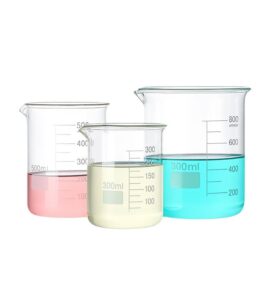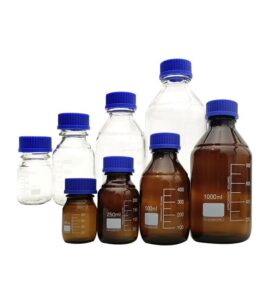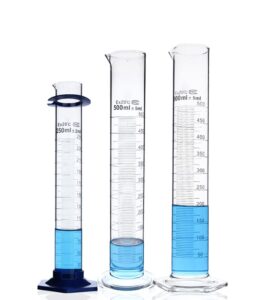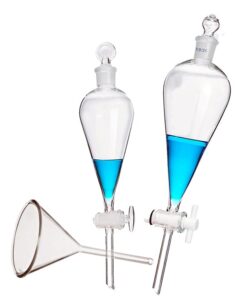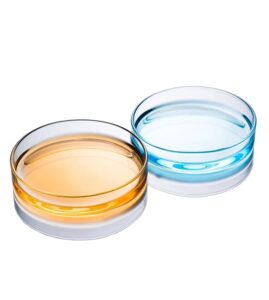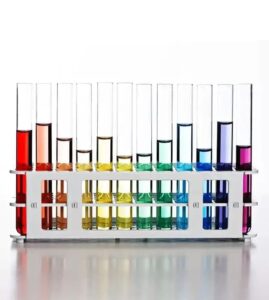Have you ever found yourself lost in the world of laboratory glassware? Or maybe you’ve been curious about those peculiar looking containers featured in almost every science movie? Yes, you’ve got it right; we’re talking about beakers! But what exactly are these beakers, and why are they a ubiquitous sight in any chemistry lab?
In a nutshell, a beaker is a simple container used in labs for mixing, stirring, and heating substances. It’s a fundamental part of a chemistry lab because of its versatility and convenience in conducting various chemical reactions.
So, What Exactly is a Beaker?
The humble beaker is a cylindrical container, typically made of glass, with a flat bottom and a small spout for easy pouring. It is one of the simplest and yet most commonly used pieces of laboratory equipment. The sides of a beaker usually have graduated markings that indicate volume, although it should be noted that these measurements are approximate and not meant for precision tasks.
Why are Beakers so Popular in Chemistry Labs?
Beakers are popular because they are versatile and can be used for a wide range of tasks in a lab. Their primary function is to hold and mix chemical solutions. The flat bottom allows a beaker to be easily placed on a hot plate or heating mantle for heating solutions, and the spout allows for easy and controlled pouring.
Beakers are also robust, which makes them ideal for rough handling, like mixing or swirling solutions. They can withstand heat, cold, and pressure, making them suitable for a variety of chemical reactions.
The Science Behind Beakers: Materials and Design
Beakers may seem simple at first glance, but their design and the material used in their manufacture are rooted in science. Most beakers are made of borosilicate glass, which is highly resistant to thermal shock, chemical corrosion, and mechanical stress, making it the ideal material for laboratory glassware.
The cylindrical design of a beaker, combined with a flat bottom, ensures stability and uniform heating. The small spout on the beaker’s rim is designed for precise pouring, while the wide mouth allows for easy addition or removal of substances.
How are Beakers Different from other Lab Glassware?
It might be tempting to lump all lab glassware together, but each piece has its function. For instance, Erlenmeyer flasks and volumetric flasks are more accurate for measuring volumes. In contrast, beakers are used for more general purposes like mixing or heating solutions.
How to Use a Beaker in a Lab?
Using a beaker in a chemistry lab is quite straightforward. You can pour the desired substance into the beaker, using the spout to avoid spillage. To mix substances, you can stir with a glass rod, ensuring even distribution of the components. If you’re heating the substance, make sure you use appropriate safety equipment, including gloves and goggles, to prevent accidents.
Are There Different Types of Beakers?
Indeed, there are. Beakers come in different types, primarily distinguished by their shape and size. There are low-form beakers (also known as short-form beakers) and tall-form beakers. Low-form beakers are more common and versatile, while tall-form beakers are often used for applications that require more vertical space, such as electrochemistry experiments.
The capacity of beakers can range from a tiny 1 milliliter up to several liters. In most labs, you’ll typically find beakers ranging from 100 milliliters to 1000 milliliters.
How to Clean and Store Beakers?
Cleaning and storing beakers properly is essential to maintain their longevity and effectiveness. After usage, beakers should be rinsed with an appropriate solvent to remove any residual substances. Then, they should be washed with a mild detergent and warm water. It’s vital to rinse them thoroughly with distilled water to ensure there are no detergent residues.
Once cleaned, beakers should be allowed to dry before storing them upside down in a dry, clean place. Storing them upside down ensures that dust and other contaminants do not enter the beaker.
What are Some Common Mistakes to Avoid with Beakers?
Although beakers are quite durable, they’re not invincible. Avoid using a single beaker for incompatible chemicals as this can lead to cross-contamination. Also, when heating a beaker, ensure that the heat is evenly distributed to prevent it from cracking. Do not use a beaker with chips or cracks, as this could lead to a breakage under stress.
Safety First: Beakers and Laboratory Safety
While we’ve discussed a lot about beakers, it’s crucial to stress the importance of safety when using them in a lab. Proper usage of beakers is a key part of maintaining a safe lab environment. A few safety tips can go a long way, such as never using a beaker to directly measure or consume food or drink.
Heat-resistant gloves should be used when handling hot beakers, and safety goggles are necessary to protect the eyes from possible splashes. Moreover, when dealing with hazardous chemicals, always use beakers in a well-ventilated area or under a fume hood.
Eco-Friendly Aspects of Beakers
Another advantage of beakers is their eco-friendly nature. Glass beakers are reusable and recyclable, making them an environmentally friendly choice for laboratories. Compared to disposable plastic labware, glass beakers produce less waste and have a lower carbon footprint.
However, it’s important to dispose of broken glassware properly, and contaminated beakers must be cleaned before recycling to avoid harmful chemicals from entering the environment.
Beakers in the Professional World
Beyond academia, beakers have numerous applications in the professional world. They are used extensively in research and development laboratories across various industries, including pharmaceuticals, food and beverage, cosmetics, and environmental testing.
Beakers also play a critical role in quality control and assurance processes, ensuring products meet the necessary safety and performance standards.
Beakers Beyond Chemistry Labs
While we’ve focused on the use of beakers in chemistry labs, it’s interesting to note that beakers have uses beyond these laboratories. They are used in biology labs for culturing organisms, in physics labs for fluid mechanics experiments, and in industry for various tests and measurements.
Moreover, their iconic shape has been appropriated by pop culture, often symbolizing science in general, and they are regularly featured in movies, TV shows, and even on clothing and merchandise.
Beakers in Education
Beakers are also an integral part of science education, from elementary schools to universities. They are one of the first pieces of lab equipment that students come into contact with and continue to be a useful tool as they advance in their studies. Beakers introduce students to the fundamentals of laboratory work, including measurement, mixing, heating, and observation.
Future of Beakers
Looking into the future, the simple beaker will continue to be an essential part of labs. However, we may see innovations in beaker technology, such as self-stirring beakers or smart beakers equipped with sensors for real-time data collection and monitoring.
Final Thoughts
So there you have it, the humble beaker – a seemingly simple piece of lab equipment that plays a monumental role in scientific exploration and discovery. It’s a testament to the fact that science, at its core, relies on even the simplest of tools to uncover the complexities of our world.
Be it chemistry, biology, physics, or even the artistic world of pop culture, the beaker stands tall and proud, a silent partner in the relentless pursuit of knowledge.


